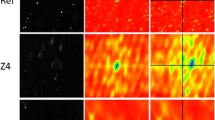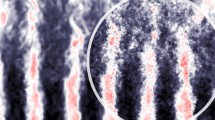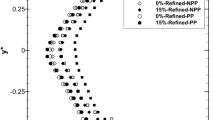Abstract
Aero-optical distortion effects on the accuracy of particle image velocimetry (PIV) are investigated. When the illuminated particles are observed through a medium that is optically inhomogeneous due to flow compressibility, the resulting particle image pattern is subjected to deformation and blur. In relation to PIV two forms of error can be identified: position error and velocity error. In this paper a model is presented that describes these errors and particle image blur in relation to the refractive index field of the flow. In the case of 2D flows the model equations can be simplified and, furthermore, the background oriented schlieren technique (BOS) can be applied as a means to assess and correct for the optical error in PIV. The model describing the optical distortion is validated by both computer simulation and real experiments of 2D flows. Two flow features are considered: one with optical distortion normal to the velocity (shear layer) and one with optical distortion in the direction of the flow (expansion fan). Both simulation and experiments demonstrate that the major source for the velocity error is the second derivative of the refractive index in the direction of the velocity vector. The aero-optical distortion effect is less critical for shearing interfaces in comparison with compression/expansion fronts, the most critical case being represented by shock waves. Based on the results from the simulated experiments, it is concluded that for the 2D flow case the BOS method allows a measurement of the mean velocity error in PIV and can reduce it to a large extent.










Similar content being viewed by others
References
Abart JC, Molton P, Maury B, Jacquin L (2004) Implantation de la PIV dans la soufflerie transsonique S3Ch. 9th congrès francophone de vélocimétrie laser, Brussels, Belgium, paper K.2
Elsinga GE, van Oudheusden BW, Scarano F, Watt DW (2004a) Assessment and application of quantitative schlieren methods: calibrated color schlieren and background oriented schlieren. Exp Fluids 36:309–325
Elsinga GE, van Oudheusden BW, Scarano F (2004b) Evaluation of aero-optical distortion effects in PIV. In: 12th international symposium on application of laser technology to fluid mechanics, Lisbon, Portugal, paper 24.4
Haertig J, Havermann M, Rey C, George A (2002) Particle image velocimetry in Mach 3.5 and 4.5 shock-tunnel flows. AIAA J 40:1056–1060
Klinge F, Riethmuller ML (2002) Local density information obtained by means of the background oriented schlieren (BOS) method. In: 11th international symposium on application of laser technology to fluid mechanics, Lisbon, Portugal, paper 15.3
Raffel M, Kost F (1998) Investigation of aerodynamic effects of coolant ejection at the trailing edge of a turbine blade model by PIV and pressure measurements. Exp Fluids 24:447–461
Raffel M, Richard H, Meier GEA (2000) On the applicability of background oriented optical tomography for large-scale aerodynamic investigations. Exp Fluids 28:477–481
Richard H, Raffel M (2001) Principle and applications of the background oriented schlieren (BOS) method. Meas Sci Technol 12:1576–1585
Scarano F, Riethmuller ML (2000) Advances in iterative multigrid PIV image processing. Exp Fluids 29, S051
Scarano F, van Oudheusden BW (2003) Planar velocity measurements of a two-dimensional compressible wake. Exp Fluids 34:430–441
Sourgen F, Haertig J, Rey C (2004) Comparison between background oriented schlieren measurements (BOS) and numerical simulations. In: 24th AIAA aerodynamic measurement technology and ground testing conference, Portland OR, USA, paper AIAA 2004-2602
Urban WD, Mungal MG (2001) Planar velocity measurements in compressible mixing layers. J Fluid Mech 431:189–222
Watt DW, Donker Duyvis FJ, van Oudheusden BW, Bannink WJ (2000) Calibrated schlieren and incomplete Abel inversion for the study of axisymmetric wind tunnel flows. In: 9th international symposium on flow visualization, Edinburgh, Scotland
White FM (1991) Viscous fluid flow. McGraw-Hill, New York
Acknowledgements
This work is supported by the Dutch Technology Foundation STW under the ‘VIDI Vernieuwingsimpuls’ program Grant DLR.6198.
Author information
Authors and Affiliations
Corresponding author
Appendix
Appendix
1.1 Scaling rules for high-speed industrial experimental facilities
Equation 2 indicates that the optical displacement vector, hence the error in the position of a particle, increases with W2 (ZD and integration length S being proportional to W). Therefore, the problem of optical distortion increases rapidly with the linear dimension (L) of the wind tunnel test section. Note that going from a small-scale research wind tunnel (L~0.1 m) to industrial scale facilities (L~1 m) commonly involves a scale factor for L2, hence W2, on the order of 100. However, the model dimensions and the flow features associated with the inviscid flow behaviour generally scale linearly with the wind tunnel size as well. As a consequence, the field of view is also linearly increased. Viscous flow features are expected to scale less than linear, with L0.5 for laminar flow and approximately L0.8 for turbulent flow (White 1991). Therefore it is expected that ∇n decreases with L−0.5 or L−0.8 (for a prescribed free stream density level) and that ∇2n hence decreases with L−1 or L−1.6 for laminar and turbulent flow, respectively. In conclusion, it is estimated that in dimensional units the position error (Eq. 2) scales at most as L1.5, or in pixel units as L0.5. The direct velocity error (Eq. 6) scales at most as L in dimensional units.
At optical interfaces, i.e. shock waves, the refractive index is discontinuous (its derivatives vary strongly with \( {\ifmmode\expandafter\vec\else\expandafter\vecabove\fi{x}} \)) and therefore Eqs. 2 and 6 no longer hold. In the vicinity of the interface, strong particle image blur is expected accompanied by a significant velocity error. The extent for the particle image blur scales as W, hence L, as is shown by Eq. 10. In pixel units the enlargement is independent of L.
Rights and permissions
About this article
Cite this article
Elsinga, G.E., van Oudheusden, B.W. & Scarano, F. Evaluation of aero-optical distortion effects in PIV. Exp Fluids 39, 246–256 (2005). https://doi.org/10.1007/s00348-005-1002-8
Received:
Revised:
Accepted:
Published:
Issue Date:
DOI: https://doi.org/10.1007/s00348-005-1002-8




